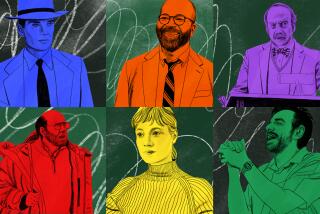Community Essay : ‘Our Only Weapon Is Our Teaching’
- Share via
We were a motley crew of teachers--swapping battle stories, eating nachos and sipping colorful drinks in the lobby of a convention hotel. Inevitably, the topic of racism and its variations surfaced through the academic banter.
Over the sound of the waterfall above us, the tales began to flow. The instructor from Los Angeles who met with the parents of a boy whose obnoxious behavior constantly disrupted the class. The only thing the Russian immigrant parents wanted to know was if the two girls he bothered were “colored.” The physical education teacher in Modesto who shouted out “white power” when a lone Caucasian boy scored a basket in a basketball game during class.
The conversation evolved into “Can you top this?” We heard about the honors algebra teacher in Palo Alto who joked, “Just give me all Chinese.” The popular science teacher in Orange County who bragged of his answer to a question posed by a seventh grader, an African American boy, who articulately asked what classes he should take to become an entrepreneur. In near hysterics, the teacher, we were told, wheezed out between chuckles, “I told him not to to worry ‘cause he could just be a pimp.”
After that one, our group screamed in disbelief, then sadly quieted down. One person sighed, “I just teach.” when confronted with such daunting realities.
With the riots, Proposition 187, the demise of affirmative action, O.J. and whatever future powder kegs await, racism touches our classrooms every day. We can’t stop other teachers and administrators who hold tenure or power. And with a full load of classes, we have no time to change the rest of the world. Our only weapon (and hope) is our own teaching.
Last year I showed a film, “Racism at Berkeley High,” for my eighth graders. I felt that many of the issues presented in the film were visible at our school, (the self-imposed grouping of ethnic groups at lunch, the dearth of Latinos and African Americans in honors and gifted classes). The only work I required was a one-page paper reacting to the film.
What I got was just as shocking as the lounge conversation at the hotel. My students asked questions: “Are whites and Asians more intellectual than blacks and Latinos?” The recounted personal stories: “One Latino boy walked by me and said, “Look at that Chinese [expletive] over there,” and admitted their own prejudices: “I see a bunch of black kids disrespecting everyone, pushing, shoving, saying, ‘Hey, [expletive] Hey, [expletive] and so I think, ‘Ah, black person. He must be like all the others.” Others just got angry: “I feel that all the history teachers don’t do their job. They always teaching European History, Buddhism, and stuff like that, never teach about my black heritage. [Expletive] all this [expletive], man.”
As I sat at my desk sifting through papers, highlighting the lines of rage, fear, and confusion, I felt many of the same emotions well up inside of me. Fear and sadness, I’d been told, are the wellsprings of anger, and for me, this definition held true. I was afraid of all this ignorance, and saddened that not much had changed in our society.
I called a diversity relations consultant (Char Givhan, at HumanCulture) and read the papers to her. With her advice and assistance, I prepared a teach-in. We turned the provocative or shocking phrases into colored flyers and posted them all over the foyer of our school’s auditorium, making a sort of museum of mirrors (or the “hall of shame” as one student put it) where the kids could look at their thoughts and those of their classmates.
All day long I walked my classes around in silence to look at their words of intolerance and asked them in writing to react once more. And for three days of our teach-in we shared, listened and began to understand one another better. In one heated session, tears from both students and their teacher broke free. And when we got back to stories, writing and the curriculum, it seemed as though the rapids of prejudice had reached a calming pool of awareness.
Since that time, I and many others remain in our classrooms doing what we can, choosing our battles and latching onto causes. Trying, as best as we can, to take on the world.
As for my colleagues around the state, I’m looking forward to our reunion; I’ve tales of hope to bring.
More to Read
Sign up for Essential California
The most important California stories and recommendations in your inbox every morning.
You may occasionally receive promotional content from the Los Angeles Times.













